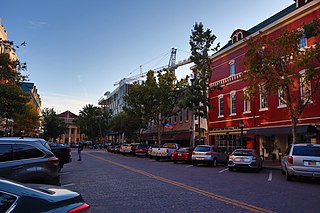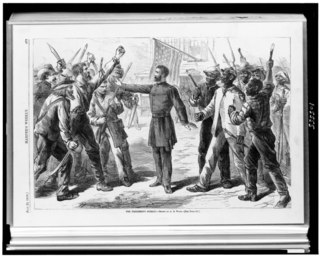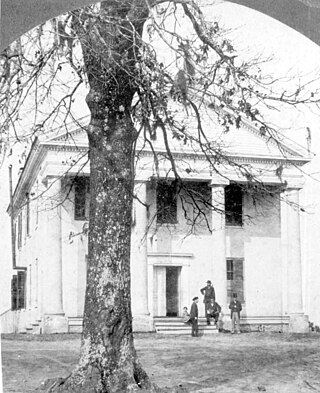
Alachua County is a county in the north central portion of the U.S. state of Florida. As of the 2020 census, the population was 278,468. The county seat is Gainesville, the home of the University of Florida.

Alachua is the second-most populous city in Alachua County, Florida and the third-largest in North Central Florida. According to the 2020 census, the city's population was 10,574, up from 9,059 at the 2010 census. It is part of the Gainesville, Florida Metropolitan Statistical Area. Alachua has one of the largest bio and life sciences sectors in Florida and is the site for the Santa Fe College Perry Center for Emerging Technologies.

Gainesville is the county seat of Alachua County, Florida, United States, and the most populous city in North Central Florida, with a population of 145,212 in 2022. It is the principal city of the Gainesville metropolitan area with a population of 350,903 in 2022.

High Springs is a city in Alachua County, Florida, United States. It is the fourth-largest city in Alachua County and seventh-largest in North Central Florida. The population was 6,215 at the 2020 census, up from 5,350 at the 2010 census. It is part of the Gainesville, Florida Metropolitan Statistical Area.

Micanopy is a town in Alachua County, Florida, United States, located south of Gainesville. It is part of the Gainesville, Florida Metropolitan Statistical Area. The population as of the 2020 census was 648, up from 600 at the 2010 census.

The Bureau of Refugees, Freedmen, and Abandoned Lands, usually referred to as simply the Freedmen's Bureau, was a U.S. government agency of early post American Civil War Reconstruction, assisting freedmen in the South. It was established on March 3, 1865, and operated briefly as a federal agency after the War, from 1865 to 1872, to direct provisions, clothing, and fuel for the immediate and temporary shelter and supply of destitute and suffering refugees and freedmen and their wives and children".

Alachua County Public Schools is a public school district serving all of Alachua County in North Central Florida. It serves approximately 29,845 students in 64 schools and centers.

Newnansville, Florida was one of the first American settlements in the interior of Florida. It became the second county seat of Alachua County in 1828, and one of the central locations for activity during the Second Seminole War, during which time it was one of the largest cities in the State. In the 1850s, the Florida Railroad bypassed Newnansville, resulting in the county seat being moved to the new town of Gainesville in 1854. Consequently, Newnansville began to decline, and when a second railway bypassed the town in 1884, most of its residents relocated and formed the new City of Alachua. By 1900, Newnansville was deserted.

The Alachua County Library District (ACLD) is an independent special taxing district and the sole provider of public library service to approximately 280,000 citizens of Alachua County, Florida. This includes all of the incorporated municipalities in the county. It maintains a Headquarters Library and four other branches in Gainesville. There are branch locations in seven of the eight other incorporated municipalities in the county. ACLD also operates a branch at the county jail, and two bookmobiles.

The history of Florida State University dates to the 19th century and is deeply intertwined with the history of education in the state of Florida and in the city of Tallahassee. Florida State University, known colloquially as Florida State and FSU, is one of the oldest and largest of the institutions in the State University System of Florida. It traces its origins to the West Florida Seminary, one of two state-funded seminaries the Florida Legislature voted to establish in 1851.

The history of the University of Florida is firmly tied to the history of public education in the state of Florida. The University of Florida originated as several distinct institutions that were consolidated to create a single state-supported university by the Buckman Act of 1905. The oldest of these was the East Florida Seminary, one of two seminaries of higher learning established by the Florida Legislature. The East Florida Seminary opened in Ocala 1853, becoming the first state-supported institution of higher learning in the state of Florida. As it is the oldest of the modern University of Florida's predecessor institutions, the school traces its founding date to that year. The East Florida Seminary closed its Ocala campus at the outbreak of the American Civil War and reopened in Gainesville in 1866.
Leonard G. Dennis was a Reconstruction-era political boss in Alahuca County, Florida, best known for his role in throwing the 1876 presidential election to the Republican candidate, Rutherford B. Hayes.

William Reuben Thomas was a politician and businessman from Gainesville, Florida.
Harmon Murray was an African-American who briefly achieved notoriety in 1890 and 1891 as the reputed leader of a feared criminal gang in northern Florida, and for killing a number of men, including a sheriff and a deputy sheriff, before being killed himself by an acquaintance.
Orange Creek is a small stream in north-central and northeast Florida, that drains Orange Lake to the Ocklawaha River. Privately owned Orange Springs provides part of the water volume.

Lincoln High School was a public high school for African American students in Gainesville, Florida during the segregation era. It replaced the Union Academy, founded with support from the Freedmen's Bureau in 1867. Lincoln High School was built in 1923 at Northwest 7th Avenue. When it was first constructed it only served grades 1–11, but the principal A. Quinn Jones campaigned for it to serve through grade 12 so students could graduate with diplomas and continue on to attend college or universities. In 1926, Jones succeeded in persuading the county board, and Lincoln High School became the second fully accredited African-American High School in the state of Florida. The A. Quinn Jones House is preserved as a museum honoring his legacy.
The city of Gainesville, Florida, USA, was incorporated in 1869.
Henry S. Harmon was an attorney and politician in Florida after the Civil War. He was the first African-American to be admitted to the bar in Florida.
The East Florida Seminary was an institution of higher learning established by the State of Florida in 1853, and absorbed into the newly established University of Florida in 1905. The school operated in Ocala from 1853 until 1861. After being closed during the Civil War, the school re-opened in Gainesville, Florida in 1866.
Gordon is a community in northern Alachua County, Florida.














